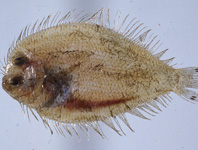Abstract
The morphology of the first zoea stage of Chaceon affinis is described and illustrated in detail for the first time. Morphological comparison with the corresponding stage of other known species of Geryonidae allowed the differentiation between the genera Chaceon and Geryon, although it was impossible to distinguish among species of Chaceon using larval morphology. Thus, geryonid larvae collected in the plankton of Gran Canaria Island, NE Atlantic, during the years 2005 and 2006, could only be identified as Chaceon spp. The temporal distribution of larval abundance suggested that main hatching periods of Chaceon spp. occur in spring and summer. These results are useful to better understand the reproductive strategies of these deep-water crabs, which in turn will be useful for future fishery management of this resource of increasing interest in the Canary Islands.
References
Biscoito, M. (1993) An account on the shrimps of the family Pandalidae (Crustacea, Decapoda, Caridea) in Madeiran waters. Courier Forschungsinstitut Senckenberg, 159, 321–325.
Biscoito, M., Freitas, M., Pajuelo, J.G., Triay-Portella, R., Santana, J.I., Costa, A.L., Delgado, J. & González, J.A. (2015) Sex-structure, depth distribution, intermoult period and reproductive pattern of the deep-sea red crab Chaceon affinis (Brachyura, Geryonidae) in two populations in the north-eastern Atlantic. Deep Sea Research I, 95, 99–114.
https://doi.org/10.1016/j.dsr.2014.10.010Brattegard, T. & Sankarankutty, C. (1967) On the prezoea and zoea of Geryon tridens Kröyer (Crustacea, Decapoda), Sarsia, 26, 7–12.
https://doi.org/10.1080/00364827.1967.10409570Castro, J.J., Hernández-García, V., Santana-Ortega, A.T., Pérez-González, Y., Trujillo-Santana, A., Caballero-Alfonso, A.M. & Ganzedo, U. (2010) Contribution to the biology and fishery of the deep-water red crab, Chaceon affinis (A. Milne-Edwards & Bouvier, 1894) (Decapoda, Brachyura, Geryonidae) in deep waters of the Canary Islands (Central-East Atlantic). Crustaceana, 83, 1231–1249.
https://doi.org/10.1163/001121610X526988Clark, P.F., Calazans, D.K. & Pohle, G.W. (1998) Accuracy and standardization of brachyuran larval descriptions. Invertebrate Reproduction & Development, 33, 127–144.
https://doi.org/10.1080/07924259.1998.9652627Davie, P. & Türkay, M. (2009) Geryonidae. World Register of Marine Species. Available from: http://www.marinespecies.org/aphia.php?p=taxdetails&id=106762 (accessed 05 November 2017)
dos Santos, A. & González-Gordillo, J.I. (2004) Illustrated key for the identification of the Pleocyemata (Crustacea: Decapoda) zoeal stages, from the coastal region of south-western Europe. Journal of the Marine Biological Association of the United Kingdom, 84, 205–227.
https://doi.org/10.1017/S0025315404009075hGonzález, J.A. (2016) Brachyuran crabs (Crustacea: Decapoda) from the Canary Islands (eastern Atlantic): checklist, zoogeographic considerations and conservation. Scientia Marina, 80, 89–102.
González, J.A., Santana, J.I. & Fernández-Vergaz, V. (1996) The family Geryonidae (Decapoda, Brachyura) in the Canary Islands. Crustaceana, 69, 627–635.
https://doi.org/10.1163/156854096X00637Guerao, G., Abelló, P. & Castejón, M.R. (1996) Morphology of the larval stages of the deep-sea crab Geryon longipes (Brachyura: Geryonidae). Journal of Natural History, 30, 505–521.
https://doi.org/10.1080/00222939600770271Ingle, R.W. (1979) The larval and post-larval development of the brachyuran crab Geryon tridens Kröyer (Family Geryonidae) reared in the laboratory. Bulletin of the British Museum (Natural History), 36, 217–232.
Koslow, J.A., Boehlert, G.W., Gordon, J.D.M., Haedrich, R.L., Lorance, P. & Parin, N. (2000) Continental slope and deep-sea fisheries: implications for a fragile ecosystem. ICES Journal of Marine Science, 57, 548–557.
https://doi.org/10.1006/jmsc.2000.0722Landeira, J.M., Lozano-Soldevilla, F. & Hernández-León, S. (2013) Temporal and alongshore distribution of decapod larvae in the oceanic island of Gran Canaria (NW Africa). Journal of Plankton Research, 35, 309–322.
https://doi.org/10.1093/plankt/fbs089López-Abellán, J.L., Balguerías, E. & Fernández-Vergaz, V. (2002) Life history characteristics of the deep-sea crab Chaceon affinis population off Tenerife (Canary Islands). Fisheries Research, 58, 231–239.
https://doi.org/10.1016/S0165-7836(01)00384-8Metaxas, A. & Kelly, N. (2010) Do larval supply and recruitment vary among chemosynthetic environments of the deep sea? PLoS ONE, 5 (7), e11646.
https://doi.org/10.1371/journal.pone.0011646Ng, P.K., Guinot, D. & Davie, P.J. (2008) Systema Brachyurorum: Part I. An annotated checklist of extant brachyuran crabs of the world. Raffles Bulletin of Zoology, 17, 1–286.
Norse, E.A., Brooke, S., Cheung, W.W.L., Clark, M.R., Ivar, E., Froese, R., Gjerde, K.M., Haedrich, R.L., Heppell, S.S., Morato, T., Morgan, L.E., Pauly, D., Sumaila, R. & Watson, R. (2012) Sustainability of deep-sea fisheries. Marine Policy, 36, 307–320.
https://doi.org/10.1016/j.marpol.2011.06.008Perkins, H.C. (1973) The larval stages of the deep sea red crab Geryon quinquedens Smith, reared under laboratory conditions (Decapoda: Brachyrhyncha). Fishery Bulletin, 71, 69–82.
Roberts, C.M. (2002) Deep impact: the rising toll of fishing in the deep sea. Trends in Ecology & Evolution, 17, 242–245.
https://doi.org/10.1016/S0169-5347(02)02492-8Robinson, M. (2008) Minimum landing size for Northeast Atlantic stocks of deep-water red crab, Chaceon affinis (Milne Edwards and Bouvier, 1894). ICES Jorunal of Marine Science, 65,148–154.
https://doi.org/10.1093/icesjms/fsm189Sampedro, M.P., Fariña, A.C. & Valeiras, J. (2001) Morphometric Analysis of Chaceon affinis (Brachyura: Geryonidae) in the North west of Iberian Peninsula. NAFO Scientific Council Research, Serial No. N4533, NAFO SCR Doc. 01/139, 1–6.
Sánchez, F. & Olaso, I. (1985) Presencia de Geryon affinis (Milne-Edwards & Bouvier, 1894), en el golfo de Vizcaya (Decapoda, Brachyura). Boletín del Instituto Español de Oceanografía, 2, 155–157.
Stuck, K.C., Perry, H.M., Stuck, L.M. & Barrett, A.A. (1992) Larval development of the golden crab, Chaceon fenneri (Manning & Holthuis, 1984) (Decapoda: Brachyura: Geryonidae), reared in the laboratory. Proceedings of the Biological Society of Washington, 105, 521–539.
Torres, A.P., dos Santos, A., Alemany, F. & Massutí, E. (2013) Larval stages of crustacean species of interest for conservation and fishing exploitation in the western Mediterranean. Scientia Marina, 77, 149–160.
https://doi.org/10.3989/scimar.03749.26DTuset, V., Espinosa, D., García-Mederos, A., Santana, J.I. & González, J.A. (2011) Egg development and fecundity estimation in deep-sea red crab, Chaceon affinis (Geryonidae), off the Canary Islands (NE Atlantic). Fishery Research, 109, 373–378.
https://doi.org/10.1016/j.fishres.2011.02.021Yearsley, J.M. & Sigwart, J.D. (2011) Larval transport modeling of deep-sea invertebrates can aid the search for undiscovered populations. PLoS ONE, 6 (8), e23063.
https://doi.org/10.1371/journal.pone.0023063Young, C.M. (2003) Reproduction, Development and Life History Traits. In: Tyler, P.A. (Ed.), Ecosystems of the Deep Oceans. Elsevier, London, pp. 381–426.

